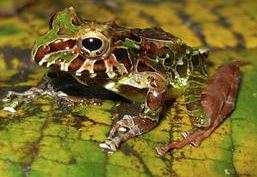Rats Help Colombia Sniff Out Deadly Landmines
11 white-furred rats are in the final stages of a training program to find landmines that kill or injure hundreds of people each year in conflict-wracked Colombia.

Ten new species of amphibians — including three kinds of poison dart frogs and three transparent-skinned glass frogs — have been discovered in the mountains of Colombia, scientists announced Monday.
Herpetologists from Conservation International (CI) and ornithologists from the Ecotrópico Foundation recorded their discoveries while on an expedition designed to explore the variety of species found in the region.
Over a period of three weeks, in Colombia's mountainous Tacarcuna area of the Darien, near the border with Panama, the scientists identified approximately 60 different species of amphibians, 20 reptiles and almost 120 species of birds, many of them apparently found no where else. (Above right – New species of rain frog found in Colombia: Photo by Marco Rada, Conservation International
The potentially new species of amphibians include three glass frogs, so called because their transparent skin can reveal internal organs; three poison dart frogs of the Dendrobatidae family, one harlequin frog; two species of rain frogs, including a spiky-skinned, orange-legged one; and a salamander. Colombia holds one of the most diverse amphibian communities in the world, with 754 species currently recorded.
"Without a doubt this region is a true Noah's Ark. The high number of new amphibian species found is a sign of hope, even with the serious threat of extinction that this animal group faces in many other regions of the country and the world," said Jose Vicente Rodriguez-Mahecha, Scientific Director of CI-Colombia.
In addition to the new discoveries, the expedition recorded the presence of large mammals such as Baird's tapir, listed on the IUCN Red List as Endangered in Colombia, and four species of monkeys, including Geoffroy's spider monkey, Geoffroy's tamarin or red crested bare-faced tamarin (Saguinus geoffroyi), white-throated capuchin or Gorgona white-fronted capuchin and the mantled howler monkey. They also found populations of white-lipped peccary.
Other surprising findings included the presence of Central American species recorded for the first time in the northern area of South America, including a salamander, a rain frog, a small lizard and a snake not yet identified.
Scientists consider amphibians important indicators of ecosystem health. With porous, absorbent skin, they often provide early warnings of environmental degradation caused by acid rain, or contamination from heavy metals and pesticides that can also harm people. Amphibians help control the spread of many diseases, such as malaria and dengue fever, because they eat the insects that deliver these diseases to human populations. In addition, amphibians are extremely susceptible to unusual weather variations, with many species impacted by climate change.
(Above- New species of glass frog discovered in Colombia: Photo by Marco Rada, Conservation International)
Although the natural cover of the Darien region is currently relatively undisturbed, it faces many threats and is undergoing rapid landscape transformation, mainly due to selective wood extraction, extensive cattle ranching, illicit crop cultivation, hunting, mining and habitat fragmentation. Between 25 and 30 percent of the natural vegetation of the area is being deforested, especially in the lowlands and alluvial plains.
Results of the expedition are expected to contribute to strengthening the protected area status that applies to almost all the Colombian Darien region, and to help bring about the declaration of a new protected area in the Tacarcuna hills. In addition, an important goal is to support initiatives that guarantee the land rights for the indigenous Emberá community of Eyakera through the creation of an Indigenous Reserve, and the development of management plans appropriate for the area and its population.
The identity and names of the new found species will be presented to the scientific community and the environmental authorities to evaluate their conservation status or risk of extinction.
Be the first to comment